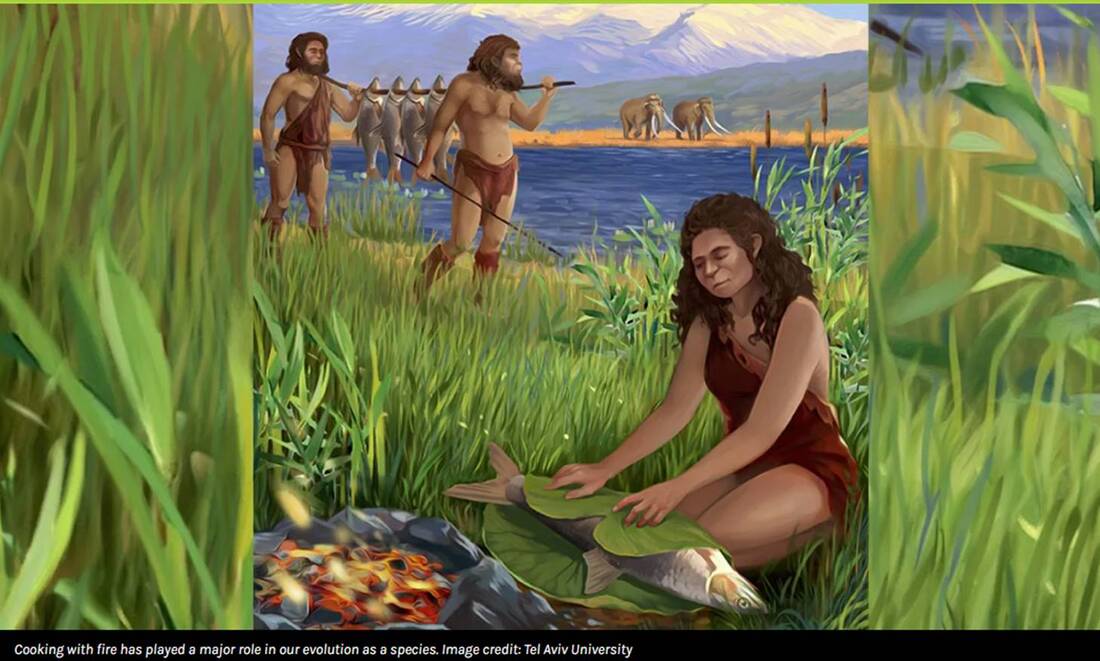Ben Taub IFL Science The gigantic carp wasn't cooked over an open flame, and may have been carefully baked in an earthen oven.Archaeologists in Israel have discovered evidence of what may be the first-ever baked fish supper. After analyzing the remains of an enormous extinct carp, the study authors concluded that the animal was carefully cooked at a low-to-moderate heat 780,000 years ago, pushing back the earliest use of fire to prepare food by over 600,000 years. Mastery of fire is seen as a major milestone in human evolution as it allowed our ancient ancestors to cook and digest food more easily, leaving more energy available for cognitive development. According to the study authors, cooked fish in particular may have facilitated brain growth and sharper intellect in extinct hominid species, laying the groundwork for our present acumen and culinary skills. “Although fish can be eaten raw, cooked fish are more nutritious, safer to eat, easier to digest and, when cooked by steaming or baking (but not grilling), they retain their [docosahexaenoic acid] and eicosapentaenoic acid contents,” they write. “When fish cooking first began, however, is still unknown and there is no consensus as to when hominins first developed the ability to control fire and cook.” While some evidence exists to suggest that Homo erectus may have figured out how to use fire by 1.7 million years ago, it’s unclear if they utilized it for food preparation. Until now, the earliest direct evidence for cooking fires had been attributed to ancient communities of Neanderthals and modern humans some 170,000 years ago. However, carp teeth discovered in a layer of sediment dated to 780,000 years ago at the Gesher Benot Ya'aqov (GBY) archaeological site suggest that earlier hominid species were already baking their fish in the more distant past. Using X-ray powder diffraction to analyze the size and structure of enamel crystals within these teeth, the researchers determined that they had been cooked at a controlled temperature of less than 500°C (932°F). “Identification of the cooking method practiced by the GBY inhabitants is indeed a challenge, especially since no traces of cooking apparatus have been preserved at the site,” write the study authors. “Nonetheless, ethnographic and experimental studies indicate that fish cooking requires production of low–moderate heat (300–500°C [572–932°F]), while preventing fast cooling or direct burning. One possibility, therefore, is that the GBY inhabitants used some kind of earth oven that maintained a temperature below 500°C to cook their fish.” Commenting on these findings in a statement, study authors Dr Irit Zohar and Dr Marion Prevost explained that “the large quantity of fish remains found at the site proves their frequent consumption by early humans, who developed special cooking techniques.” “These new findings demonstrate not only the importance of freshwater habitats and the fish they contained for the sustenance of prehistoric man, but also illustrate prehistoric humans' ability to control fire in order to cook food, and their understanding the benefits of cooking fish before eating it." The study is published in the journal Nature Ecology & Evolution. Comments are closed.
|
Mapping America's Native Food Trailto reduce suffering Categories
All
|
Special Recognition to our friend Dr. Rudy Coronado Jr. for his relentless friendship and advice
Map Partner: Aaron Carapella - Tribal Nations Maps (949) 415-4981 [email protected]
This project is a result of a PURC Fellowship from the University of N.C. at Pembroke and
Endorsed by the Native American non-profit Sanctuary on the Trail 501(c)3
Site powered by Weebly. Managed by iPage
Map Partner: Aaron Carapella - Tribal Nations Maps (949) 415-4981 [email protected]
This project is a result of a PURC Fellowship from the University of N.C. at Pembroke and
Endorsed by the Native American non-profit Sanctuary on the Trail 501(c)3
Site powered by Weebly. Managed by iPage
Fair Use Notice
This website may contain copyright material, the use of which has not been specifically authorized by the copyright owner. If we make such material available, it is in an effort to advance understanding of environmental, political, human rights, economics, democracy, scientific, and social justice issues, etc. We believe this constitutes a “fair use” of any such copyrighted material as provided for in section 107 of the U.S. Copyright Law. In accordance with Title 17 U.S.C. Section 107, the material on this site is distributed without profit to those who have expressed a prior interest in receiving the included information for research and educational purposed. Our non-profit’s transformative mission is to provide new decolonized content to help educate the general public and help reduce suffering. Our information can be awareness provoking using factual content.

 RSS Feed
RSS Feed




